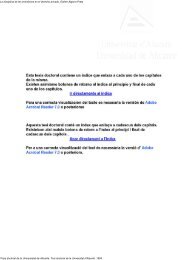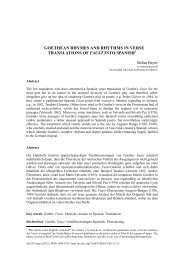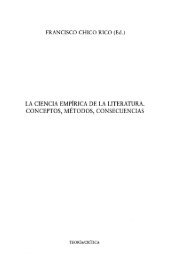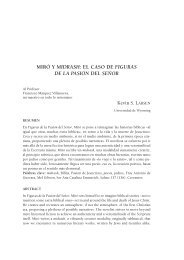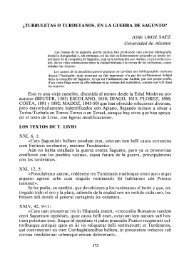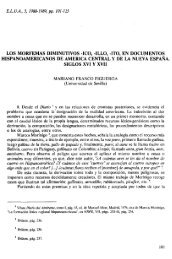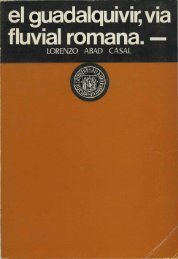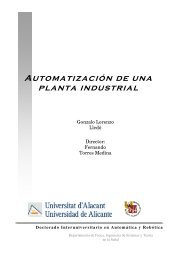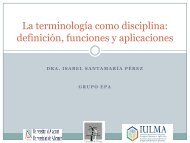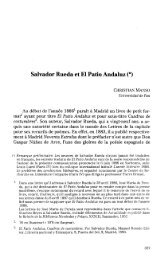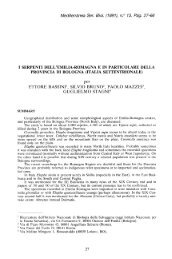ecological effects of marine protected areas empafish project ...
ecological effects of marine protected areas empafish project ...
ecological effects of marine protected areas empafish project ...
Create successful ePaper yourself
Turn your PDF publications into a flip-book with our unique Google optimized e-Paper software.
EMPAFISH Booklet no. 1 Ecological <strong>effects</strong> <strong>of</strong> Atlanto-Mediterranean MPAs in the EU<br />
samples were collected during summer and autumn in 1995 and 1996 at the<br />
16 FADs using a surrounding net. Visual observations <strong>of</strong> fishes associated with<br />
the FADs were also conducted to obtain qualitative information about the<br />
spatial distribution <strong>of</strong> species.<br />
A total <strong>of</strong> 1632 specimens weighing 144 kg and belonging to 8 species were<br />
caught during the survey. Seriola dumerili, Caranx crysos, C. rhonchus and<br />
Coryphaena hippurus were the most frequent and abundant species<br />
accounting for 96% <strong>of</strong> the total catch. Average fish abundance and weight,<br />
characterised by high variance, were significantly higher at the sites with<br />
experimental FADs than at the sites with traditional FADs. S. dumerili was the<br />
only species with higher catches around the experimental FADs. Some spatial<br />
and temporal variations in fish abundance and size were also detected.<br />
Younger individuals <strong>of</strong> S. dumerili were observed to show high affinity for the<br />
experimental FAD tufts. This studies highlights the role and the efficiency <strong>of</strong><br />
bottom and floating FAD not only in attracting fish, but also in hosting and<br />
supporting a characteristic fish assemblage.<br />
The role <strong>of</strong> floating FADs in the distribution and shoreward migrations <strong>of</strong><br />
juvenile <strong>of</strong> the greater amberjack Seriola dumerili has also been studied in the<br />
Gulf <strong>of</strong> Castellammare (Sinopoli et al. 2006). In this study, we hypothesised<br />
that FADs located along a distance gradient from the shore might lead the<br />
greater amberjack inshore. In such case, mean abundance <strong>of</strong> S. dumerili<br />
should decrease over time in <strong>of</strong>fshore FADs and increase in inshore FADs. To<br />
test the hypothesis three FAD systems were positioned in the Gulf <strong>of</strong><br />
Castellammare (Sicily, Italy), between July and September 2001, at<br />
increasing distances from the coast. During the study period, five visual<br />
censuses were carried out within FADs fields. During the first sampling<br />
period, no significant difference in abundance and size <strong>of</strong> juvenile S.<br />
dumerili were found between the three FAD systems. All the other<br />
sampling periods reported higher abundances and sizes in the <strong>of</strong>fshore FADs<br />
than in the two inshore FADs. The findings suggest that FAD systems might<br />
be exerting two different <strong>effects</strong> on YOY S. dumerili distribution: (a) <strong>of</strong>fshore<br />
FADs tend to retain associated fish for longer periods <strong>of</strong> time, (b)<br />
coastal FADs favour the transition <strong>of</strong> YOY S. dumerili from the pelagic to the<br />
benthic domain.<br />
A preliminary Cellular Automata model was also developed to visualise and<br />
predict the behaviour <strong>of</strong> juveniles <strong>of</strong> the greater amberjack Seriola dumerili<br />
during the first year <strong>of</strong> life in the presence <strong>of</strong> fish aggregating devices (FADs)<br />
(Piscitelli et al., 2000, 2001). The model was utilised for simulations,<br />
concerning the area <strong>of</strong> the Castellammare Gulf, NW Sicily. First simulations<br />
have given encouraging results; they account for the main characteristics <strong>of</strong><br />
the phenomenon and agree with the observations. The results show that the<br />
model could be applied for the optimization <strong>of</strong> FADs distribution and the<br />
evaluation <strong>of</strong> their environmental impact.<br />
� Marine ranching<br />
A pilot experiment <strong>of</strong> <strong>marine</strong> ranching using hatchery-reared juveniles <strong>of</strong><br />
white seabream, Diplodus sargus, was made in the Gulf <strong>of</strong> Castellammare<br />
78



